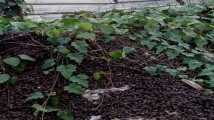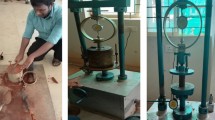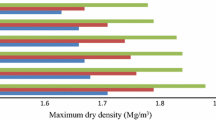Abstract
The stabilization potential of cement kiln dust (CKD) and periwinkle shell ash (PSA) was investigated using laboratory analysis. This was aimed at evaluating the effect of CKD and PSA on the stabilization of two lateritic soils for use as pavement layer materials. Two soils (Soil A and B) were treated with various percentages (by weight of dry soil) of CKD at 0, 5, 10, 15 and 20% and PSA at 0, 2, 4, 6, 8 and 10% and compacted using British Standard light (BSL) energy. Their effects were evaluated on the compaction characteristics: maximum dry density (MDD), optimum moisture content (MDD), unconfined compressive strength (UCS) and California bearing ratio (CBR) tests based on American Standard Testing Materials (ASTM) codes. Microstructural analysis using the Scanning Electron Microscope (SEM) was used to identify the morphological changes in the properties of the stabilized soils. Significant improvement with the addition of CKD and PSA was observed with increased MDD, UCS, and CBR for both soils. Peak MDD of 1.745 mg/m3 and 1.810 mg/m3 was recorded for both soil samples considered. The results of the peak unconfined compressive strength (UCS) for all the curing ages considered and California bearing ratio (CBR) were obtained at 10% CKD/8% PSA. Peak UCS of 994.17 and 1019.46 kN/m2 was obtained for soil A and B respectively. Microstructural analysis of the stabilized soils resulted in strength improvement through the formation of new compounds. Based on this study, PSA and CKD can be used to improve deficient lateritic soils for road construction.
Similar content being viewed by others
References
M. Gidigasu, Laterite soil engineering: pedogenesis and engineering principles, Elsevier Scientific Publishing, Amsterdam, Netherlands, 2012.
M. Khemissa, A. Mahamedi, Cement and lime mixture stabilization of an expansive overconsolidated clay, Appl. Clay Sci. 95 (2014) 104–110. https://doi.org/10.1016/j.clay.2014.03.017.
O.E. Oluwatuyi, O.O. Ojuri, A. Khoshghalb, Cement-lime stabilization of crude oil contaminated kaolin clay, J. Rock Mech. Geotech. Eng. 12 (1) (2020) 160–167. https://doi.org/10.1016/j.jrmge.2019.07.010.
K.J. Osinubi, P. Yohanna, A.O. Eberemu, Cement modification of tropical black clay using iron ore tailings as admixture, Transp. Geotech. 5 (2015) 35–49. https://doi.org/10.1016/j.trgeo.2015.10.001.
S. Rios, N. Cristelo, A. Viana da Fonseca, C. Ferreira, Structural performance of alkali-activated soil ash versus soil cement, J. Mater. Civ. Eng. 28 (2) (2016) 04015125. https://doi.org/10.1061/(ASCE)MT.1943-5533.0001398.
N.K. Sharma, S.K. Swain, U.C. Sahoo, Stabilization of a clayey soil with fly ash and lime: a micro level investigation, Geotech. Geol. Eng. 30 (5) (2012) 1197–1205. https://doi.org/10.1007/s10706-012-9532-3.
K.J. Osinubi, G. Moses, Compacted foundry sand treated with bagasse ash as hydraulic barrier material, in Geo-Front. Adv. Geotech. Eng., Dallas, TX, USA, 2011, pp. 915–925. https://doi.org/10.1061/41165(397)94.
A. Hashad, M. El-Mashad, Assessment of soil mixing with cement kiln dust to reduce soil lateral pressure compared to other soil improvement methods, HBRC J. 10 (2) (2014) 169–175. https://doi.org/10.1016/j.hbrcj.2013.10.004.
A.B. Salahudeen, A.O. Eberemu, K.J. Osinubi, Assessment of cement kiln dust-treated expansive soil for the construction of flexible pavements, Geotech. Geol. Eng. 32 (4) (2014) 923–931. https://doi.org/10.1007/s10706-014-9769-0.
R.K. Etim, I.C. Attah, P. Yohanna, Experimental study on potential of oyster shell ash in structural strength improvement of lateritic soil for road construction, Int. J. Pavement Res. Technol. (2020) 1–11. https://doi.org/10.1007/s42947-020-0290-y.
R.K. Etim, I.C. Attah, A.O. Eberemu, P. Yohanna, Compaction behaviour of periwinkle shell ash treated lateritic soil for use as road sub-base construction material, J. Geoengin. Taiwan Geotech Soci. 14 (3) (2019) 179–200. https://doi.org/10.6310/jog.201909_14(3).6.
A.L. Ayodele, A.O. Adebisi, M.A. Kareem, Use of Sludge Ash in Stabilising Two Tropical Laterite, Int J Sci Eng Res. 7 (8) (2016) 104–108.
A. Shivaramaiah, A.R. Shankar, A. Singh, K.H. Pammar, Utilization of lateritic soil stabilized with alkali solution and ground granulated blast furnace slag as a base course in flexible pavement construction, Int. J. Pavement Res. Technol. 13 (5) (2020) 478–488. https://doi.org/10.1007/s42947-020-0251-5.
S. Peethamparan, J. Olek, J. Lovell, Influence of chemical and physical characteristics of cement kiln dusts (CKDs) on their hydration behavior and potential suitability for soil stabilization, Cem. Concr. Res. 38 (6) (2008) 803–815. https://doi.org/10.1016/j.cemconres.2008.01.011.
A.A. Amadi, A.O. Eberemu, Performance of cement kiln dust in stabilizing lateritic soil contaminated with organic chemicals, Adv. Mater. Res. 367 (2012) 41–47 https://doi.org/10.4028/www.scientific.net/AMR.367.41.
S. Peethamparan, J. Olek, Study of the effectiveness of cement kiln dusts in stabilizing Na-montmorillonite clay, J. Mater. Civ. Eng. 20 (2) (2008) 137–146. https://doi.org/10.1061/(ASCE)0899-1561(2008)20:2(137).
A.A. Amadi, Enhancing durability of quarry fines modified black cotton soil subgrade with cement kiln dust stabilization, Transp. Geotech. 1 (1) (2014) 55–61. https://doi.org/10.1016/j.trgeo.2014.02.002.
S. Kolias, V. Kasselouri-Rigopoulou, A. Karahalios, Stabilisation of clayey soils with high calcium fly ash and cement, Cem. Concr. Compos. 27 (2) (2005) 301–313. https://doi.org/10.1016/j.cemconcomp.2004.02.019.
R. Zentar, D. Wang, N.E. Abriak, M. Benzerzour, W. Chen, Utilization of siliceous-aluminous fly ash and cement for solidification of marine sediments, Constr. Build. Mater. 35 (2012) 856–863. https://doi.org/10.1016/j.conbuildmat.2012.04.024.
I.E. Ekop, O.A. Adenuga, A.A. Umoh, Strength characteristics of granite-pachimalania aurita shell concrete, Niger. J. Agric. Food Environ. 9 (2) (2013) 9–14.
A.P. Adewuyi, T. Adegoke, Exploratory study of periwinkle shells as coarse aggregates in concrete works, ARPN J. Eng. Appl. Sci. 3 (6) (2008) 1–5.
G.S. Olorunoje, O.C. Olalusi, Periwinkle shell as alternative to coarse aggregate in lightweight concrete, Int. J. Environ. Issues. 1 (1) (2003) 231–236.
A.A. Amadi, A.S. Osu, Effect of curing time on strength development in black cotton soil-Quarry fines composite stabilized with cement kiln dust (CKD), J. King Saud Univ.-Eng. Sci. 30 (4) (2018) 305–312. https://doi.org/10.1016/j.jksues.2016.04.001.
A.A. Umoh, K.O. Olusola, Compressive strength and static modulus of elasticity of periwinkle shell ash blended cement concrete, Int. J. Sustain. Constr. Eng. Technol. 3 (2) (2012) 45–55.
A.A. Amadi, A. Okeiyi, Use of quick and hydrated lime in stabilization of lateritic soil: comparative analysis of laboratory data, Int. J. Geo-Eng. 8 (1) (2017) 3. https://doi.org/10.1186/s40703-017-0041-3.
P. Chindaprasirt, A. Kampala, P. Jitsangiam, S. Horpibulsuk, Performance and Evaluation of Calcium Carbide Residue Stabilized Lateritic Soil for Construction Materials, Case Stud. Constr. Mater. (2020) e00389. https://doi.org/10.1016/j.cscm.2020.e00389.
N.C. Consoli, P.D.M. Prietto, J.A.H. Carraro, K.S. Heineck, Behavior of compacted soil-fly ash-carbide lime mixtures, J. Geotech. Geoenvironmental Eng. 127 (9) (2001) 774–782. https://doi.org/10.1061/(ASCE)1090-0241(2001)127:9(774).
S. Horpibulsuk, C. Phetchuay, A. Chinkulkijniwat, A. Cholaphatsorn, Strength development in silty clay stabilized with calcium carbide residue and fly ash, Soils Found. 53 (4) (2013) 477–486. https://doi.org/10.1016/j.sandf.2013.06.001.
E.S. Nnochiri, Geotechnical Properties of Lateritic Soil Stabilized with Periwinkle Shell Ash in Road Construction, Int. J. Adv. Eng. Manag. Sci. 2 (5) (2016) 239463.
K.J. Osinubi, M.A. Oyelakin, A.O. Eberemu, Improvement of black cotton soil with ordinary Portland cement-locust bean waste ash blend, Electron. J. Geotech. Eng. 16 (F) (2011) 619–627.
K.J. Osinubi, T.S. Ijimdiya, I. Nmadu, Lime stabilization of black cotton soil using bagasse ash as admixture, in: Adv. Mater. Res., Adv. Mater. Res. 62–64 (2009) 3–10. https://doi.org/10.4028/www.scientific.net/AMR.62-64.3.
American Society for Testing and Materials, Specification for Fly Ash and Raw or Calcined Natural Pozzolanas for Use as a Mineral Admixture in Portland Cements Concrete. ASTM C618-12a. ASTM International, West Conshohocken, PA, USA, 2013.
Federal Ministry of works and Housing, Federal Republic of Nigeria Highway Manual, General Specifications Requirement for Roads and Bridges, Abuja, Nigeria, 1997.
British Standard Institution, Methods of Test for Stabilized Soils. BSI 1924. BSI, UK, 1990.
O.E. Oluwatuyi, B.O. Adeola, E.A. Alhassan, E.S. Nnochiri, A.E. Modupe, O.O. Elemile, T. Obayanju, G. Akerele, Ameliorating effect of milled eggshell on cement stabilized lateritic soil for highway construction, Case Stud. Constr. Mater. 9 (2018) e00191.
F. Bell, Engineering treatment of soils, CRC Press, Abingdon, UK, 1993, p. 18–19.
A. Marto, N. Latifi, A. Eisazadeh, Effect of non-traditional additives on engineering and microstructural characteristics of laterite soil, Arab. J. Sci. Eng. 39 (10) (2014) 6949–6958. https://doi.org/10.1007/s13369-014-1286-1.
A. Kampala, P. Jitsangiam, K. Pimraksa, P. Chindaprasirt, An investigation of sulfate effects on compaction characteristics and strength development of cement-treated sulfate bearing clay subgrade, Road Mater. Pavement Des. (2020) 1–14. https://doi.org/10.1080/14680629.2020.1753564.
S. Horpibulsuk, R. Rachan, A. Chinkulkijniwat, Y. Raksachon, A. Suddeepong, Analysis of strength development in cement-stabilized silty clay from microstructural considerations, Constr. Build. Mater. 24 (10) (2010) 2011–2021.
G. Moses, A. Saminu, F.O.P. Oriola, Influence of Compactive Efforts on Compacted Foundry Sand Treated With Cement Kiln Dust, Civ. Environ. Res. 2 (5) (2012) 11–24.
F. Velasco, S.P. Verma, Importance of skewness and kurtosis statistical tests for outlier detection and elimination in evaluation of geochemical reference materials, Math. Geol. 30 (1) (1998) 109–128.
B.M. Das, K. Sobhan, Principles of geotechnical engineering, Cengage learning, Stamford, USA, 2013.
K.J. Osinubi, A.T. Stephen, Influence of compactive efforts on bagasse ash treated black cotton soil, Niger. J. Soil Environ. Res. 7 (2007) 92–101. https://doi.org/10.4314/njser.v7i1.28422.
M.D. Gidigasu, J.L.K. Dogbey, Geotechnical characterization of laterized decomposed rocks for pavement construction in dry sub-humid environment, in: 6th South East Asian Conf. Soil Eng, Taipei, Taiwan, 1980, pp. 493–506.
J.E. Sani, R.K. Etim, A. Joseph, Compaction behaviour of lateritic soil-calcium chloride mixtures, Geotech. Geol. Eng. 37 (4) (2019) 2343–2362. https://doi.org/10.1007/s10706-018-00760-6.
P.H. Simms, E.K. Yanful, Measurement and estimation of pore shrinkage and pore distribution in a clayey till during soil-water characteristic curve tests, Can. Geotech. J. 38 (4) (2001) 741–754. https://doi.org/10.1139/t01-014.
S. Jaritngam, O. Somchainuek, P. Taneerananon, Feasibility of laterite-cement mixture as pavement base course aggregate, Iran. J. Sci. Technol. Trans. Civ. Eng. 38 (C1+) (2014) 275.
L.R. Reyes-Gutiérrez, E.T. Romero-Guzmán, A. Cabral-Prieto, R. Rodríguez-Castillo, Characterization of chromium in contaminated soil studied by SEM, EDS, XRD and Mössbauer Spectroscopy, J. Miner. Mater. Charact. Eng. 7 (1) (2007) 59–70. https://doi.org/10.4236/jmmce.2008.71005.
Author information
Authors and Affiliations
Corresponding author
Additional information
Declaration of Interest Statement
The authors wish to declare that there is no conflict of interest known to them.
Peer review under responsibility of Chinese Society of Pavement Engineering.
Rights and permissions
About this article
Cite this article
Ekpo, D.U., Fajobi, A.B. & Ayodele, A.L. Response of two lateritic soils to cement kiln dust-periwinkle shell ash blends as road sub-base materials. Int. J. Pavement Res. Technol. 14, 550–559 (2021). https://doi.org/10.1007/s42947-020-0219-5
Received:
Revised:
Accepted:
Published:
Issue Date:
DOI: https://doi.org/10.1007/s42947-020-0219-5




